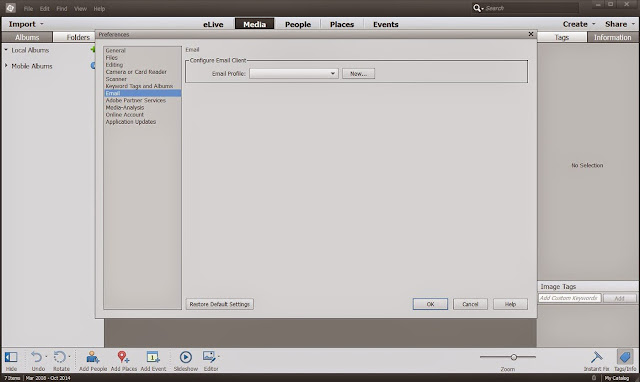Recently the question was asked "In Premiere Elements 13, how do I create a 1920 x 1080p30 file that will present in the YouTube 16:9 player with a widescreen cinematic look (black border at top and bottom of the frame) with the minimal loss of image?"
SOLUTION
Two ways to achieve the widescreen cinematic look are presented for consideration. Both involve importing as 1920 x 1080p video into 1920 x 1080p project, creating black borders in the image in Edit area of program, and exporting as 1920 x 1080p. The "Black borders in image" in Edit area of program is done in either of the following ways
- Crop effect applied to top and bottom of Image
- Interpret Footage Pixel Aspect Ratio changed to HD Anamorphic 16:9 (1.333), followed by scale adjust in project where "Default Scale To Frame Size" is disabled before import of the source into the project.
Crop Effect Applied to Top and Bottom of Image
STEP 1
Premiere Elements 13 project preset set by user (manual)* or program (automatically) to
NTSC
DSLR
1080p
DSLR 1080p30@ 29.97 or DSLR 1080p30
STEP 2
Edit Menu/Preferences/General with "Default Scale to Frame Size" enabled.
Import the source 1920 x 1080p30 file.
STEP 3
Drag the Crop effect into the Timeline 1920 x 1080 video clip. See fx Effects/Transform/Crop.
And, edit the applied Crop effect under Applied Effects Tab/Applied Effects Palette/Crop Panel expanded. In this example the Crop effect settings are Top 12%, Left 0%, Right 0%, and Bottom 12%.
 |
| Figure 1. Black Border At Top And Bottom Of Frame Created With Crop Effect. |
STEP 4
Export to either of the following
- Publish+Share/Social Websites/You Tube with preset of High Definition Video for YouTube - 1920 x 1080.
- Publish+Share/Computer/AVCHD with Presets = MP4 H.264 1920 x 1080p30 for viewing with computer player or for upload to YouTube at the YouTube website. Note that the preset MP4 H.264 1920 x 1080p30 is using the Pixel Aspect Ratio = Square Pixels (1.0).
 |
| Figure 2. YouTube Video's "Widescreen Cinematic Look" When Black Borders Created With Cropping In Edit. |
Interpret Footage Pixel Aspect Ratio changed to HD Anamorphic 16:9 (1.333), followed by scale adjust in project where "Default Scale To Frame Size" was disabled before import of the source into the project.
STEP 1
Premiere Elements 13 project preset set by user (manual)* or program (automatically) to
NTSC
DSLR
1080p
DSLR 1080p30@ 29.97 or DSLR 1080p30
STEP 2
Edit Menu/Preferences/General with "Default Scale to Frame Size"DISABLED".
Import the source 1920 x 1080p30 file, using Expert workspace's Add Media/Files and Folders/Project Assets.
STEP 3
In Project Assets, right click the thumbnail for the file. Select Interpret Footage. In the Interpret Footage dialog, go to the Pixel Aspect Ratio section, dot the Conform To:, and set the Conform To: to HD Anamorphic 16:9 (1.333).
STEP 4
Drag the video from Project Assets to the Expert workspace Timeline. Click on that Edit area monitor. Note the bounding box that appears around the image in the monitor. It extends beyond the area of the frame. With the mouse cursor, use the bounding box handle (as soon in Figure 3a) to zoom out so that the whole image fits in the Edit area monitor space for 1920 x 1080.
 |
| Figure 3a. Creating The Top Bottom Black Borders The Interpret Footage Pixel Aspect Ratio Way - Preparing To Zoom Out. |
 |
| Figure 3b. Creating The Top Bottom Black Borders The Interpret Footage Pixel Aspect Ratio Way - Zoom Out Completed. |
STEP 5
Export to either of the following
- Publish+Share/Social Websites/You Tube with High Definition Video for YouTube - 1920 x 1080.
- Publish+Share/Computer/AVCHD with Presets = MP4 H.264 1920 x 1080p30 for viewing with computer player or for upload to YouTube at the YouTube website. Note that the preset MP4 H.264 1920 x 1080p30 is using the Pixel Aspect Ratio = Square Pixels (1.0).
The sample video uploaded to YouTube from within the Premiere Elements 13 YouTube feature appeared at YouTube as seen in Figure 4.
 |
| Figure 4. YouTube Video's "Widescreen Cinematic Look" When Black Borders Created With Interpret Footage Pixel Aspect Ratio And Scaling Changes In Edit.
|
The work described above was done with Premiere Elements 13 on Windows 7 Professional SP1 64 bit in a NTSC setup. However, what has been reported here should be applicable in principle to other versions of Premiere Elements on other computer operating systems and using counterpart PAL settings.
The merits of one approach versus the other are still being thought about.
______________________________________________________________________________
*
http://atr935.blogspot.com/2013/04/pe11-accuracy-of-automatic-project.html














































